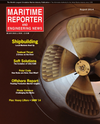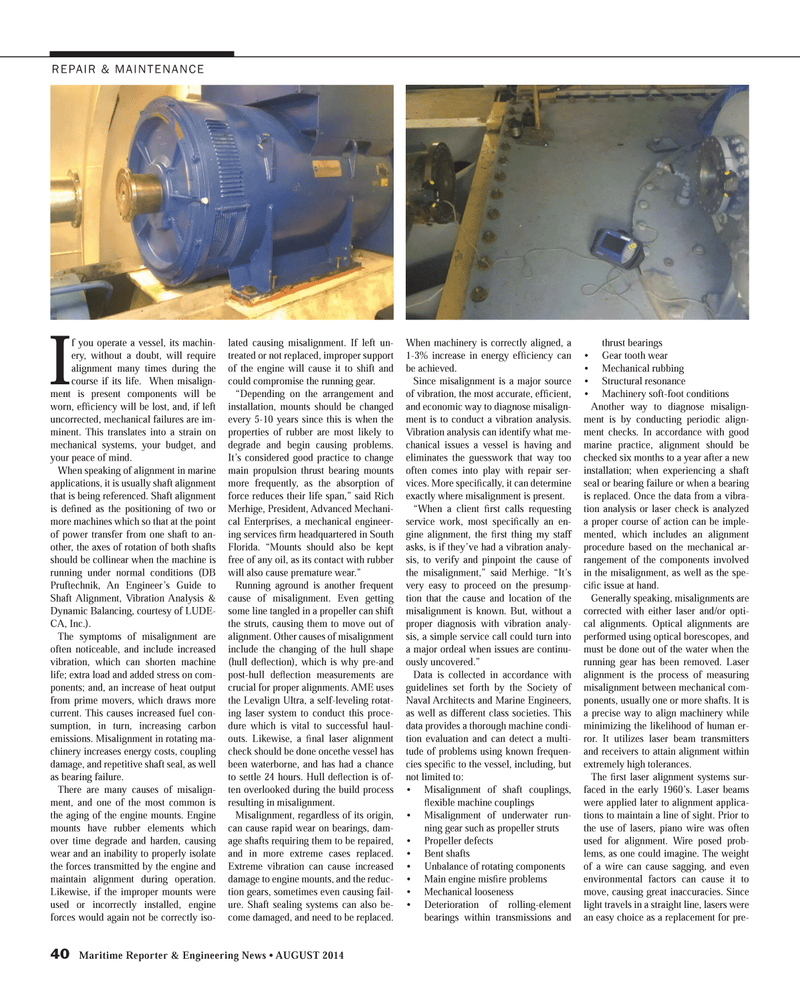
Page 40: of Maritime Reporter Magazine (August 2014)
Shipyard Edition
Read this page in Pdf, Flash or Html5 edition of August 2014 Maritime Reporter Magazine
40 Maritime Reporter & Engineering News ? AUGUST 2014 If you operate a vessel, its machin-ery, without a doubt, will require alignment many times during the course if its life. When misalign- ment is present components will be worn, efÞ ciency will be lost, and, if left uncorrected, mechanical failures are im-minent. This translates into a strain on mechanical systems, your budget, and your peace of mind.When speaking of alignment in marine applications, it is usually shaft alignment that is being referenced. Shaft alignment is deÞ ned as the positioning of two or more machines which so that at the point of power transfer from one shaft to an-other, the axes of rotation of both shafts should be collinear when the machine is running under normal conditions (DB Pruftechnik, An Engineer?s Guide to Shaft Alignment, Vibration Analysis & Dynamic Balancing, courtesy of LUDE-CA, Inc.).The symptoms of misalignment are often noticeable, and include increased vibration, which can shorten machine life; extra load and added stress on com-ponents; and, an increase of heat output from prime movers, which draws more current. This causes increased fuel con- sumption, in turn, increasing carbon emissions. Misalignment in rotating ma-chinery increases energy costs, coupling damage, and repetitive shaft seal, as well as bearing failure.There are many causes of misalign-ment, and one of the most common is the aging of the engine mounts. Engine mounts have rubber elements which over time degrade and harden, causing wear and an inability to properly isolate the forces transmitted by the engine and maintain alignment during operation. Likewise, if the improper mounts were used or incorrectly installed, engine forces would again not be correctly iso-lated causing misalignment. If left un-treated or not replaced, improper support of the engine will cause it to shift and could compromise the running gear. ?Depending on the arrangement and installation, mounts should be changed every 5-10 years since this is when the properties of rubber are most likely to degrade and begin causing problems. It?s considered good practice to change main propulsion thrust bearing mounts more frequently, as the absorption of force reduces their life span,? said Rich Merhige, President, Advanced Mechani- cal Enterprises, a mechanical engineer- ing services Þ rm headquartered in South Florida. ?Mounts should also be kept free of any oil, as its contact with rubber will also cause premature wear.? Running aground is another frequent cause of misalignment. Even getting some line tangled in a propeller can shift the struts, causing them to move out of alignment. Other causes of misalignment include the changing of the hull shape (hull deß ection), which is why pre-and post-hull deß ection measurements are crucial for proper alignments. AME uses the Levalign Ultra, a self-leveling rotat-ing laser system to conduct this proce-dure which is vital to successful haul-outs. Likewise, a Þ nal laser alignment check should be done oncethe vessel has been waterborne, and has had a chance to settle 24 hours. Hull deß ection is of- ten overlooked during the build process resulting in misalignment.Misalignment, regardless of its origin, can cause rapid wear on bearings, dam-age shafts requiring them to be repaired, and in more extreme cases replaced. Extreme vibration can cause increased damage to engine mounts, and the reduc-tion gears, sometimes even causing fail-ure. Shaft sealing systems can also be-come damaged, and need to be replaced. When machinery is correctly aligned, a 1-3% increase in energy ef Þ ciency can be achieved.Since misalignment is a major source of vibration, the most accurate, efÞ cient, and economic way to diagnose misalign-ment is to conduct a vibration analysis. Vibration analysis can identify what me- chanical issues a vessel is having and eliminates the guesswork that way too often comes into play with repair ser- vices. More speciÞ cally, it can determine exactly where misalignment is present. ?When a client Þ rst calls requesting service work, most speciÞ cally an en- gine alignment, the Þ rst thing my staff asks, is if they?ve had a vibration analy-sis, to verify and pinpoint the cause of the misalignment,? said Merhige. ?It?s very easy to proceed on the presump-tion that the cause and location of the misalignment is known. But, without a proper diagnosis with vibration analy-sis, a simple service call could turn into a major ordeal when issues are continu-ously uncovered.?Data is collected in accordance with guidelines set forth by the Society of Naval Architects and Marine Engineers, as well as different class societies. This data provides a thorough machine condi-tion evaluation and can detect a multi-tude of problems using known frequen-cies speciÞ c to the vessel, including, but not limited to: ? Misalignment of shaft couplings, ß exible machine couplings ? Misalignment of underwater run- ning gear such as propeller struts? Propeller defects ? Bent shafts ? Unbalance of rotating components ? Main engine mis Þ re problems ? Mechanical looseness ? Deterioration of rolling-element bearings within transmissions and thrust bearings? Gear tooth wear ? Mechanical rubbing ? Structural resonance ? Machinery soft-foot conditions Another way to diagnose misalign-ment is by conducting periodic align-ment checks. In accordance with good marine practice, alignment should be checked six months to a year after a new installation; when experiencing a shaft seal or bearing failure or when a bearing is replaced. Once the data from a vibra-tion analysis or laser check is analyzed a proper course of action can be imple-mented, which includes an alignment procedure based on the mechanical ar- rangement of the components involved in the misalignment, as well as the spe-ciÞ c issue at hand. Generally speaking, misalignments are corrected with either laser and/or opti-cal alignments. Optical alignments are performed using optical borescopes, and must be done out of the water when the running gear has been removed. Laser alignment is the process of measuring misalignment between mechanical com-ponents, usually one or more shafts. It is a precise way to align machinery while minimizing the likelihood of human er- ror. It utilizes laser beam transmitters and receivers to attain alignment within extremely high tolerances.The Þ rst laser alignment systems sur- faced in the early 1960?s. Laser beams were applied later to alignment applica-tions to maintain a line of sight. Prior to the use of lasers, piano wire was often used for alignment. Wire posed prob- lems, as one could imagine. The weight of a wire can cause sagging, and even environmental factors can cause it to move, causing great inaccuracies. Since light travels in a straight line, lasers were an easy choice as a replacement for pre-REPAIR & MAINTENANCE MR #8 (34-41).indd 40MR #8 (34-41).indd 408/4/2014 11:22:11 AM8/4/2014 11:22:11 AM

 39
39

 41
41
